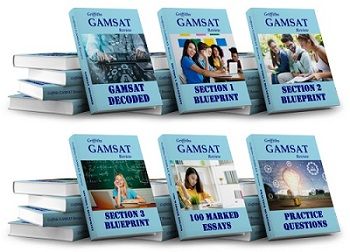GAMSAT Section 1
Section 1 Overview
Section 1 Things To Do First
Source Material In Section 1
Section 1 Suggested Materials
Putting It Into Practice
Gamsat section 1 is not usually the section students are most worried about, that honour normally falls to section 3. However it is the section that students often have the most difficulty preparing for. This is due to two main reasons:
1. Lack of a defined syllabus.
While the Gamsat syllabus for the science section is by no means clear one could at least make a reasonable guess based on the level that ACER recommends studying to (first year degree level) and the topics usually found in science courses at that level. ACER even conveniently informs us that 80% is based on biology and chemistry and only 20% on physics.
However no such advice is given for section 1. We are only given some rather vague and unhelpful jargon that questions in this section will test
"skills in the interpretation and understanding of ideas in social and cultural contexts".
And while they give us some information on the types of base material will be used to set the questions there is no detail as to what proportion each of these will appear.
2. Lack of preparation materials.
While you can just go out and buy some textbooks for the science, what do you buy for section 1? Do you go and buy a load of novels or poetry books? Even a complete beginner to Gamsat could work out that isn't a very good strategy but what exactly is the answer to this conundrum?
In this article we will attempt to address these issues and set out a simple strategy by which you can begin to take the uncertainty out of section one.
Section 1 Overview
Section I is the first challenge that you will undertake while completing the GAMSAT. This section involves 47 multiple-choice questions to be completed within 70 minutes. Section I is considered by many to be the most difficult section for students to improve their score in.
At first glance, one might assume that Section I is simply reading comprehension, but upon further evaluation into what examiners are looking for, you will find Section I to be much deeper than just that. More than a test of IQ, Section I assesses the interplay of IQ and EQ, requiring you to use your emotional intelligence and empathy to read between the lines of a particular social situation.
Section I examines your ability to infer emotions and details through written or visual cues. As emotional intelligence is a necessity for this section and EQ is a quality that cannot simply be taught, Section I has garnered somewhat of a reputation of having a fixed score that cannot be improved in subsequent sittings. While it is true that high emotional intelligence is not a quality that can be instilled into you overnight, there are some sure-fire ways in which you can prepare for this section to ensure dramatic improvement before the exam day.

Section 1 Things To Do First
Before we get into the detail though I'd like to mention four things right at the outset that can drastically improve your section one performance.
Don't Be Complacent
The first and most important thing to say is to not be complacent about section 1. Many students think "it's just a reading comprehension test".
But while this is true it is also not true. Included in section 1 are many different types of questions which do not fall into the traditional reading comprehension category such as questions based on charts, diagrams, cartoons and so on.
Even for the "standard" reading comprehension type questions you'll find that the style of Gamsat questions is quite different to comprehension tests you have taken before.
Adequate preparation is key to doing well.
Too many students become complacent about Section 1
Learn To Speed Read.
One of the biggest problems with all sections of Gamsat is the time pressure. Candidates often fail to finish answering all the questions. In the humanities and social sciences paper there is a lot of text and complex information which needs to be assimilated and understood as fast as possible. So if you can improve your reading speed you will immediately gain an advantage.
So I recommend you look into a speed reading system which works for you. They do not usually need months to work and shouldn't have a detrimental impact on understanding there is even some evidence that speed reading techniques can improve reading and comprehension for dyslexics.
Most involve learning to eliminate sub-vocalisation (hearing the word in your head as you read) and minimising eye movements by scanning groups of words at a time instead of individual words.
I recommend these two links as a good starting point -
https://tim.blog/2009/07/30/speed-reading-and-accelerated-learning/
https://www.wikihow.com/Learn-Speed-Reading

To do or not to do: Skim Reading
Traditionally, this topic has come up time and time again, when it comes to having enough time and sufficient information to accurately and efficiently finish Section I:
“Should I try to skim read?”
The answer to this question does depend on your personal reading style and the way that you digest information, however, in a series of studies by researcher Ziming Liu, it was found that when your brain skim reads, there is much less time for deep reading processes and cognition.
Therefore, if you choose to skim read during Section I, you are not guaranteed to have absorbed much of the vital information needed to go answer the corresponding questions correctly. Not only that, but you may actually have to waste time going back through the text to verify whether something you thought you read was accurate.
The best way to optimise your time in Section I, without losing quality and accuracy in your answering is to work on improving your reading speed WITHOUT skim reading. You can find video after video on how to do this on YouTube, but as previously mentioned reading speed as well as confidence with digesting longer texts can be dramatically improved simply by reading every day.
One thing that can seriously affect your reading speed on the day is a lack of focus due to the stress and pressure you are under to perform well on the day. In order to prepare yourself to combat this stress, it is helpful to employ your own methods of stress relief that you know work for you, in the time leading up to your exam, be that meditation, exercise, or breathing techniques. It is also important to ensure that you have eaten a sufficient amount on the day to provide sufficient fuel for your brain to focus.
Improve Your Reading Comprehension
A second vitally important thing you can do is to adopt strategies to improve your reading comprehension. Unlike most other verbal comprehension tests where you can read the questions first and then quickly scan the text for the answer, Gamsat section 1 questions do not work in this way. In Gamsat you need a complete overall understanding of the text and the authors argument and the questions will test your grasp of these.
As such it is critical to develop this skill. One widely used model to improve reading comprehension is the PASS model, which stands for -
Preview
Ask and Answer questions
Summarize
Synthesize
In the Preview stage you just read the heading or first couple of lines of each section or paragraph, review what you already know about the topic and try to predict what the text is about.
The Ask phase focuses on asking a systematic set of questions about the paragraph to ensure you have an understanding of the piece or the authors argument . These questions are "Who" "What" "When" "Where" "Why" and "How". If the answers do not match your predictions from the Preview stage you need to ask yourself why and how they differ.
Summarize, restate in your own words what the paragraph is about or what argument it is trying to make.
In the final step, Synthesize, say how the paragraph relates to the text as a whole and build up a mental map of the whole text.
Further resources for improving reading comprehension can be found here:
https://blog.prepscholar.com/how-to-improve-reading-comprehension
Learn Critical Thinking
Wikipedia defines critical thinking as
"the analysis.. which includes the rational, skeptical, unbiased analysis, or evaluation of factual evidence... of facts to form a judgement."
A large part of this includes logical reasoning, spotting logical fallacies in arguments, processing information and looking at all sides of an argument to reach a reasoned conclusion.
These skills will help you apply the comprehension you obtained from the reading comprehension skills detailed above to choosing the correct answers to questions based on the text. The questions frequently contain statements about the text and you will need to be able to discern if they logically represent the arguments made by the author.
Refer to Wikipedia for more information on critical thinking.
https://en.wikipedia.org/wiki/Critical_thinking#In_computer-mediated_communication
The Foundation for Critical Thinking also has a Youtube channel with some interesting videos on this topic.
Source Material In Section 1
The source material for questions in section 1 will be taken from the following:
1. Fiction Text - this could be novels, short stories, plays etc. In fact there are almost an infinite number of different styles of writing which can be encompassed here.
You will also be exposed to numerous literary devices so it is worthwhile exploring these and making sure you are very familiar with them. Of key importance with this kind of text is to always be aware of the overall tone of the text, the motivations of the characters and their attitudes to each other.
2. Non Fiction - could be excerpts from political, social, economic or philosophical works or even taken from technical manuals, , legislation, guides, reports and so on.
Whatever the base text, just don't expect it to be particularly interesting. The boring texts which make an appearance in this section will be as much a test of your attention span as your reading comprehension.
3. Poems - as with non-fiction texts you will be required to understand the overall mood of the poem as well as the motivations and attitudes of any characters which appear in them.
However within poetry you will need to read between the lines and glean this information not just from the plain meanings of words but also with reference to the phonic qualities of the words, the rhymes and the imagery which they conjure.
The good news with poems is that they are normally short self contained works and you can easily read and study many in a short time frame, unlike for example reading a novel.
4. Proverbs or popular sayings - these will usually be obscure examples which you haven't heard before. They will be aiming to test your ability to unravel the meaning of weirdly constructed phrases or unfamiliar vocabulary. A good strategy with this type of question is to try and rephrase the saying in your own words.
5. Cartoons - will put to the test your understanding of different types of humour, satire, exaggeration, inference and implication.
6. Diagrammatic Reasoning - questions requiring interpretation of some kind of diagram. Again don't expect it to be of a kind you have seen before. However regularly practicing this type of problem can improve your ability to rapidly understand and solve them.
7. Charts or tables - extracting information from some kind of mathematical tabulation or data.
Types Of Questions Based on The Source Material
All the questions in section 1 will be in the multiple choice format and will be of three kinds -
1. Understanding - recognising both explicit and implicit meanings of the text, or a character in the text.
2. Reasoning - which implies reaching conclusions, connecting ideas and extrapolating.
3. Critical thinking - the use of reasoning to make judgments.
Section 1 Suggested Materials
You have a large amount of different types of source material which needs to be covered so you need to set up a reading program which can cover as many of the different types of material stated above as efficiently as possible.
To do that let's nail a common misconception first:
DON'T Read Widely
You'll often see this advice given on Gamsat forums, blogs etc. Read widely they always say. But in reality this advice is next to useless when you actually try and put it into practice.
What people who say this really mean is "I don't really know what works so read widely and maybe some of it will be useful".
Or maybe they just repeat it parrot like because everyone else is saying it.
So my advice is don't "read widely" or to put it a better way DON'T just pick up anything that comes to hand with no plan or strategy in mind to make your reading useful and more importantly, likely to improve your score in the test.
So don't adopt a scatter gun approach, your reading needs to be focused on the sort of materials likely to come up in the test and above all needs to be time efficient.
It isn't a good idea for example to start reading long novels, or poetry books etc as not only is that too time consuming but is also unlikely to instill the skills necessary for answering Gamsat questions.
Rather I recommend to begin regularly reading short texts: Set yourself a time limit to read them and while reading continually apply all the principles set out above regarding comprehension and critical thinking.
A good place to start is a quality daily newspaper which will typically contain short articles on many different topics from politics, economy, the arts, science, travel, contemporary culture etc. From there you can expand to short stories, poems and so on.
Here is a list of resources you may find useful:
Quality newspapers and magazines with varied articles:
https://www.theguardian.com/international
Free short stories you can read online -
https://americanliterature.com/100-great-short-stories
Poems -
https://www.poetryfoundation.org/poems
Short Essays - on a variety of topics and downloadable as free PDF's
http://australianhumanitiesreview.org/
Cartoons -
A great site for finding cartoons on many different topics (not just political which most cartoon sites tend to concentrate on is
For diagrammatic reasoning a good website which allows you to practice various types of test is https://www.assessmentday.co.uk/ try several of their tests for example the mechanical reasoning test, numerical reasoning, inductive reasoning and others. They are all useful practice for Gamsat style questions.
Further Reading List
As emphasized previously try and read authors who write short articles, stories or essays which are similar to the type of text found in Section 1. Some recommended authors are Noam Chomsky, George Orwell, A C Grayling and Ben Dupré.

Putting It Into Practice
So now we've got a good grasp of what will be in the test and what materials to read to prepare let's put it all together and see how we can now actually practice the above.
Use The Acer Materials
Having begun to begin to read texts and poems and other types of source materials you'll need to start practicing questions.
The first and most important materials you should buy are the official ACER practice tests which you can get from ACER when you register for the test. These remain the best and most realistic examples of questions that come up in the real test. Although there is frequently debate about how close the section 3 questions in these are to the real test the student feedback I get every year consistently says that the section 1 questions are very similar to the real test and that section one changes very little year on year.
The ACER practice tests come in the form of PDF downloads but I recommend you print them out to get the most realistic question practice possible similar to real test conditions. You can underline, annotate and so on as you would in the real test.
Unfortunately the amount of official ACER materials is limited, there are only three full length practice tests so at some stage you may want to buy some more commercially available materials. That's fine and will give you some good extra practice but start with the ACER papers first.
Keep A Question Log
The whole point of practice is to learn from your mistakes. The best way to do this is to keep track of questions you've answered during your practice in a question log and record the type of source material (i.e. fiction, non-fiction, poem etc) and the type of question such as reasoning, inference and so on and record whether or not you got the correct answer. A great way to do this quickly is set up a spreadsheet.
Over time you'll see patterns beginning to emerge which will direct you to which areas you need to dedicate more time to.
Develop Accuracy First
As you work your way through questions you should first concentrate on developing your technique to choose the right answer. Don't worry too much about speed at the beginning, that will come automatically as you begin to get better at reading, understanding and identifying question types.

Gamsat is notorious for being a very time pressured test. It is very common for students to be unable to complete all the questions in the time allowed in Section 3. In fact there has been much speculation that the test may even be designed on purpose to make it difficult to finish.
You will be relieved to hear however that most people CAN complete section 1 in the time allowed.
If you are consistently having trouble finishing all the questions then have a look at the tips I set out above regarding speed reading.
Create A Language Log
In the same way as you gain insight through a question log a language log can help you to improve vocabulary and your recognition of literary devices. In the course of your reading if you encounter some new vocabulary the write it down and write down the meaning. Likewise if you are unsure regarding literary devices and are uncertain on the definition of allegory or alliteration then record it in your language log.
But let's be sensible here - some estimates put the number of words in the English language at over a million. Even a standard large dictionary contains around 300,000 words.
So the chances of recording a word in your language log and then it actually coming up in the test are statistically low.
This is why it's important to select your reading material carefully (see comments above in the section titled "Don't Read Widely") and also select the words you're going to record in your log with care.
It's much better to concentrate on the type of contemporary language and vocabulary widely in use today rather than an obscure 14th century term for pig.
This is particularly important for overseas students and candidates whose first language is not English.
Reflection & Discussion
GAMSAT Section 1 preparation is as much about having high quality discussions about questions and your answer choices with your fellow students as it is about completing practice questions and reading the recommended range of texts. Such discourse will facilitate you to question and challenge interpretations and the validity of arguments.
This reflective process enables you to have a more robust and broader reflection on the logical links you’ve made in response to the GAMSAT questions and the answers you arrived at.
You can meet fellow students by joining my Gamsat Facebook group here - https://www.facebook.com/groups/gamsatstudy
Don't Be Overawed
My final piece of advice when you read a passage for section 1 is do not allow yourself to be overawed or intimidated by any particular kind of text. Most of the texts selected for the humanities paper will not be the kind of thing you'd choose to read for fun. Mostly they will be selected precisely for their difficulty and uncommon vocabulary so don't be surprised to see a text on 17th century Russian socio-economics. The most important thing is to not become dismayed when encountering a text on an unfamiliar topic. Just work through it steadily using the principles you've practiced many times.

Further Resources
For more help with Section 1 please also see Griffiths Gamsat Review which has a more complete analysis of all the different question types which can appear in GAMSAT Section 1 with detailed strategies for answering them quickly.

You May Also Like...
Gamsat Preparation - a complete plan
